Saying "yes" often feels like the easier, kinder option. We agree to take on extra work, attend social events we are not excited about, or help a friend when we are already stretched thin. We do this to be helpful, to avoid conflict, or to maintain our reputation as a reliable person. This habit of saying yes to everything, however, can lead to burnout, stress, and resentment. Learning to say "no" is not about being selfish; it is a vital act of self-care and boundary setting. Mastering this skill allows you to protect your time, energy, and well-being. This article is here to guide you, offering clear and practical strategies to help you say no confidently and without the guilt.
Why Saying "No" Feels So Difficult
The guilt that comes with saying "no" is a common and powerful feeling. Understanding its origins is the first step toward overcoming it. For many of us, this difficulty is rooted in a deep-seated desire to be liked and to avoid disappointing others. We are often socialized from a young age to be agreeable and accommodating. This "people-pleasing" tendency can make setting boundaries feel like a betrayal of our role as a good friend, partner, or employee.
Another major factor is the fear of missing out (FOMO). We might worry that saying no to an opportunity, whether social or professional, will mean we miss out on a key experience or connection. This fear can pressure us into overcommitting our schedules and energy.
Finally, we sometimes create narratives in our minds about how our "no" will be perceived. We might assume the other person will be angry, think we are lazy, or feel personally rejected. Most of the time, these imagined negative reactions are far worse than the reality. Recognizing that the guilt is often self-imposed helps you start to dismantle its power.
The Foundational Step: Know Your Priorities
You cannot protect your boundaries if you do not know where they are. Saying no effectively begins with having a clear understanding of your own priorities. When you know what is truly important to you—your goals, your values, and your non-negotiable needs—it becomes much easier to decide what deserves your "yes." Your time and energy are finite resources. Every time you say yes to one thing, you are implicitly saying no to something else.
How to Clarify Your Priorities
- Take Time for Reflection: Set aside a few quiet moments to think about what matters most to you right now. This could relate to your career, your health, your relationships, or your personal growth. What activities energize you? What goals are you working toward?
- Write It Down: Make a list of your top three to five priorities for the current season of your life. This could be things like "prioritizing my physical health," "spending quality time with family," or "finishing my degree."
- Use Your List as a Filter: When a new request or opportunity comes your way, check it against your list of priorities. Ask yourself: "Does saying yes to this align with my priorities?" This simple check-in can make your decision much clearer and less emotional.
When you decline a request because it conflicts with a core priority, you are not just saying no. You are saying yes to something more important.
Practical Strategies for a Guilt-Free "No"
Once you are clear on your priorities, you can use specific communication techniques to deliver your "no" in a way that is both kind and firm. The goal is to be respectful of the other person while still honoring your own needs.
1. Be Clear and Direct
Vague or wishy-washy responses can create confusion and leave the door open for the other person to push back. Avoid phrases like "I'm not sure," "Maybe," or "I'll try." A direct "no" is often the kindest response because it provides clarity. You can soften the delivery while still being firm.
- Example: Instead of, "I don't think I'll be able to make it," try, "Thank you so much for the invitation, but I won't be able to make it."
2. Keep It Simple
You do not owe anyone a long, elaborate explanation. Over-explaining can sometimes sound like you are making excuses, which can weaken your position and make you feel more guilty. A simple, brief reason is usually sufficient. In many cases, you do not need to give a reason at all.
- Example: Instead of a long story about your busy week, you can say, "I'm not able to take on any new projects right now," or simply, "I have another commitment."
3. Offer an Alternative (If You Want To)
Sometimes you may want to help but are unable to fulfill the specific request. In these situations, offering an alternative can show that you care and are willing to support them in a different way. This is not a requirement, but it can be a good way to maintain a positive relationship.
- Example: A colleague asks you to lead a new project you do not have time for. You could say, "I don't have the capacity to lead this project, but I'm happy to help you brainstorm some initial ideas for half an hour."
- Example: A friend asks you to help them move on a Saturday when you need to rest. You could say, "I'm not available that Saturday, but I'd love to bring you dinner on Sunday after you're all moved in."
4. Use the "Sandwich" Method
This technique involves "sandwiching" your "no" between two positive statements. It can help the other person feel appreciated while still receiving a clear answer.
- Start with a positive: "Thank you for thinking of me for this."
- State your "no": "Unfortunately, my schedule is full, so I won't be able to join the committee."
- End with a positive: "I really appreciate you considering me and I wish you all the best with the project."
Practicing Self-Compassion After You Say No
Even with the best strategies, you might still feel a pang of guilt after saying no, especially when you are just starting to build this new habit. This is where self-compassion becomes essential. Remind yourself why you said no in the first place. You did it to protect your well-being, honor your priorities, or preserve your energy for the things that matter most.
Acknowledge the feeling of guilt without letting it consume you. You can say to yourself, "I'm feeling a little guilty right now, and that's okay. I know I made the right decision for me." Each time you say no and stick with it, you are strengthening your boundary-setting muscle. Over time, it will become easier and feel more natural.
Remember that people generally respect those who have clear boundaries. Your "no" teaches others how to treat you and shows that you value your own time. This often leads to healthier, more balanced relationships in the long run.
 (Image via
(Image via





